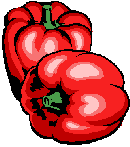
Also call: Chinese Gooseberry

 | DESCRIPTION
|
Kiwifruit is a egg-shaped fruit which consisits of little black seeds. It has a
thin brown hairy skin and the flesh is green and refreshing.
 | HISTORY AND ORIGIN
|
Kiwifruit is originally from the Yangtze Valley in China where it was grown on the
edge of the rainforest. Now the French describe 'le kiwi' as a mouse hanging by its tail.
 | BUYING AND STORAGE
|
Select large, firm and well-shaped fruit. When testing for the ripeness of
the fruit, it is usually a little bit soft when you apply a little pressure to it.
Kiwifruit can be ripen at room temperature. When it is ripe, you can store it in the
refrigerator for up to 1 week.
 | PREPARATION AND USE
|
To remove the hairs on the skin, just simply rub it with a paper towel. Cut the
fruit in half and you can eat fresh from skin.
Kiwifruit can be diced or peeled and used in fruit salad, fruit platter, fruit tarts
and can even be served with ice cream.
 | NUTRITIONAL INFORMATION
|
Kiwifruit are low in kilojoules. It has a good source of iron. With one kiwifruit
intake, you have all the vitamin C you will need for one day, as it has an excellent
source of vitamin C.
 | MAJOR NUTRIENTS
|
- SERVING SIZE: 100 grm
| * ENERGY: |
204
kj |
* IRON: |
.5 mg
|
| * PROTEIN: |
1 grm |
* POTASSIUM: |
|
| * FAT: |
.2 grm |
* CALCIUM: |
|
| * CARBOHYDRATE: |
10
grm |
* VITAMIN A: |
|
| * DIETARY FIBRE: |
3 grm |
* VITAMIN B: |
|
| * SODIUM: |
6 mg |
* VITAMIN C: |
72
mg |
 | VARIETY
|
GOLD: Golden yellow flesh, sweeter
than common Kiwifruit.
|




